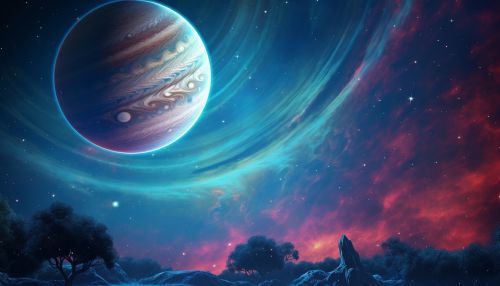Magnetosphere of Jupiter
Introduction
The Magnetosphere of Jupiter is a vast, complex structure that extends millions of kilometers into space, far beyond the planet's visible atmosphere. It is the largest and most powerful magnetosphere in the solar system, and it plays a crucial role in shaping Jupiter's environment and its interactions with the solar wind.
Formation and Structure
Jupiter's magnetosphere is generated by the planet's rapid rotation and its metallic hydrogen core, which acts as a dynamo. The magnetosphere is composed of several distinct regions, including the bow shock, magnetosheath, magnetopause, magnetotail, and the inner and outer radiation belts.


The bow shock is the outermost boundary of the magnetosphere, where the solar wind slows down and heats up as it encounters Jupiter's magnetic field. The magnetosheath is the region between the bow shock and the magnetopause, filled with turbulent plasma. The magnetopause is the boundary that separates the solar wind from the magnetospheric plasma. The magnetotail extends away from the sun and is shaped by the pressure of the solar wind.
The inner and outer radiation belts are regions of high-energy particles trapped by Jupiter's magnetic field. These belts are much stronger and more extensive than Earth's Van Allen belts, and they pose a significant challenge for spacecraft visiting Jupiter.
Dynamics and Interactions
The dynamics of Jupiter's magnetosphere are primarily driven by the planet's rapid rotation and the interaction with the solar wind. The magnetosphere rotates with the planet, sweeping up ions from Jupiter's moon Io and other sources. These ions are accelerated to high energies and contribute to the intense radiation belts.
The solar wind interaction with the magnetosphere leads to a variety of phenomena, including magnetic reconnection, plasma waves, and auroras. Magnetic reconnection is a process where the magnetic field lines break and reconnect, releasing energy and accelerating particles. Plasma waves are oscillations in the plasma that can also accelerate particles and contribute to the radiation belts.
Jupiter's magnetosphere also produces intense auroras, similar to the Northern and Southern Lights on Earth. These auroras are caused by charged particles spiraling down the planet's magnetic field lines and colliding with the upper atmosphere. The auroras on Jupiter are much more powerful than those on Earth and can be observed in various wavelengths, including ultraviolet and X-ray.
Exploration and Study
The study of Jupiter's magnetosphere has been primarily conducted through spacecraft missions, including Pioneer, Voyager, Galileo, Juno, and future planned missions. These missions have provided valuable data on the structure, dynamics, and processes within the magnetosphere.
The Pioneer and Voyager missions provided the first detailed measurements of Jupiter's magnetosphere in the 1970s and 1980s. The Galileo orbiter, which arrived at Jupiter in 1995, conducted extensive studies of the magnetosphere and its interactions with Jupiter's moons.
The Juno mission, currently in orbit around Jupiter, is providing unprecedented data on the planet's magnetic field, auroras, and magnetosphere. Future missions, such as the planned Europa Clipper and JUICE (JUpiter ICy moons Explorer) missions, will continue to study Jupiter's magnetosphere and its interactions with the planet's icy moons.
